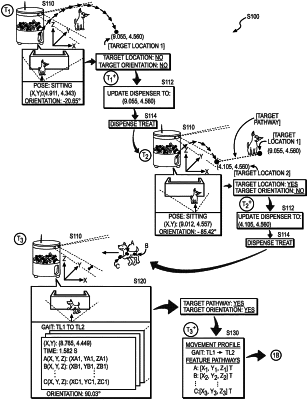| CPC A01K 29/005 (2013.01) [A01K 15/02 (2013.01)] | 13 Claims |

|
1. A method for monitoring health of an animal during autonomous training with a training apparatus, comprising:
during a first training session for an animal:
accessing a video feed recorded by an optical sensor defining a field of view intersecting a working field and integrated into the training apparatus configured to dispense units of a primary reinforcer toward a range of locations within the working field via a dispenser integrated into the training apparatus; and
in the video feed, detecting the animal in the working field;
at a first time during the first training session, dispensing a first unit of the primary reinforcer toward a first target location within the working field;
at a second time succeeding the first time during the first training session, in response to detecting the animal at the first target location, dispensing a second unit of the primary reinforcer toward a second target location within the working field and intersecting a target pathway extending from the first target location to the second target location;
during a first test period succeeding the second time during the first training session, in response to detecting movement of the animal along the target pathway in the video feed, collecting a first timeseries of position data representing changes in position of a set of anatomical features of the animal during the first test period;
deriving a first movement profile for the animal based on the first timeseries of position data, the first movement profile representing movement of the animal along the target pathway during the first test period;
accessing a baseline movement profile derived from timeseries position data of the set of anatomical features collected for the animal during a preceding time period;
characterizing a difference between the first movement profile and the baseline movement profile; and
in response to the difference exceeding a threshold difference:
interpreting a first abnormality in the first movement profile for the animal;
predicting a first causal pathway for the first abnormality based on the difference and characteristics of the first abnormality; and
selecting a first mitigation protocol for the animal based on the first abnormality and the first causal pathway.
|